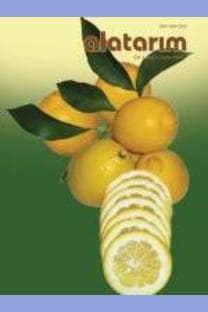Sebze (Bahçe) soya (Glycine max [L] Merr)
yetişme yeri faktörleri, soya fasulyesi, sebze yetiştiriciliği, Glycine max, kültivasyon, ekoloji
Vegetable Soybean (Glycine max [L] Merr)
site factors, soyabeans, vegetable growing, Glycine max, cultivation, ecology,
___
- Anonim, 2001. http://www.avrdc.org/LC/soybean/production/title.html.
- Haskınacı, Ş., 2004. İstanbul Ticaret Odası Etüt ve Araştırma Şubesi Soya Ürün Profili (www.gdf.org.tr).
- Konovsky J., Lumpkin, T.A., McClary, D., 1994. Edamame: The Vegetable Soybean. Pages 173-81 In A.D. O'Rourke (ed), Understanding the Japanese Food and Agrimarket: A Multifaceted Opportunity. Haworth Press, Binghamton.
- Mentreddy S.R., Mohamed, A.I., Joshee, N., Yadav., A.K., 2002. Edamame: A Nutritious Vegetable Crop Reprinted from: Trends in New Crops and New Uses. 2002. J. Janick and A. Whipkey (eds.). ASHS Press, Alexandria, VA.
- Mimura, M., Coyne, C.J., Bambuck, M.W., Lumpkin., T A., 2007. SSR Diversity of Vegetable Soybean [Glycine max (L.) Merr.] Genetic Resources and Crop Evolution (2007) 54:497–508.
- Öner, T., 2006. Soya Sektör Raporu. (www.ito.org.tr).
- Qing-Guo., Hu, Min Zhang Arun S. Mujumdar, Gong-Nian, Xiao, Jin-cai Sun., 2006. Drying of Edamames by Hot Air and Vacuum Microwave Combination. Journal of Food Engineering 77 (2006) 977–982.
- Rao, M.S.S., Bhagsari, A.S., Mohamed, A.I., 2002. Fresh Green Seed Yield and Seed Nutritional Traits of Vegetable Soybean Genotypes. Crop science. Vol. 42, No 6, pp.1950-1958.
- Shinohara, S., 1989. Vegetable Seed Production Technology of Japan, Elucidated with Respective Variety Development Histories, Particulars. Vol. II. Japan.
- Stevenson, D.G., Jane, J., Inglett, G.E., 2007. Structures and Physicochemical Properties of Starch Fromimmature Seeds of Soybean Varieties (Glycine max (L.) Exhibiting Normal, Low-Linolenic or Low-Saturated Fatty Acidoil Profiles at Maturity. Carbohydrate Polymers 70 (2007) 149–159.
- Young G., Mebrahtu, T., Johnson, J., 2000. Acceptability of Green Soybeans as A Vegetable Entity. Plant Foods for Human Nutrition 55: 323–333.
- ISSN: 1304-2653
- Yayın Aralığı: 2
- Başlangıç: 2015
- Yayıncı: Alata Bahçe Kültürleri Araştırma Enstitüsü
Narda meyve kabuğu ve dane su içeriğinin meyve çatlaması üzerine etkisi
CENAP YILMAZ, Ahsen Işık ÖZGÜVEN
Bazı erkenci mandarin çeşitlerinin Adana ekolojik koşullarındaki verim ve kalite özellikleri
Şebnem KURT, Bilge YILDIRIM, Önder TUZCU
AYDIN UZUN, TURGUT YEŞİLOĞLU, Yıldız Aka KAÇAR, Önder TUZCU, OSMAN GÜLŞEN, Übeyit SEDAY, İHSAN CANAN
Sebzelerde eşey hücrelerinin oluşumunda büyümeyi düzenleyici maddelerin etkileri
Güçer KAFA, Önder TUZCU, TURGUT YEŞİLOĞLU
Kahramanmaraş kırmızı biberlerinde tohumla taşınan virüslerin moleküler tanısı
